Medellin to San Agustin 2/12/09 to 27/12/09 892 km (total km 19623)
Since it had been nearly 10000 km since our last major service on the bikes (besides oil changes for the Rohloff hubs and new brake pads which we have done on the road), it was time for some ‘bike love’ for our trusty steeds. And in Bisono, in Manizales we had found the right man. His son is the downhill mountain biking champion of Colombia, he rides serious mountain bikes himself, and his workshop is like a candy store for any bike obsessed person. Tools hung from walls, from revolving racks, any tool that we could have dreamed of, he had, and if we didn’t he could probably make it! We ended up spending nearly two days in his chaotic workshop, boys and men coming and going with their bikes needing repairs, doing a lot of the work ourselves under his guidance we replaced cables, swapped sprockets, replaced chains while he trued our wheels, regreased hubs and bottom brackets and generally made us laugh with his loud and enthusiastic manner. Muchas gracias a Bisono, this man is probably one of the best mechanics in all of Colombia, and definitely the friendliest.
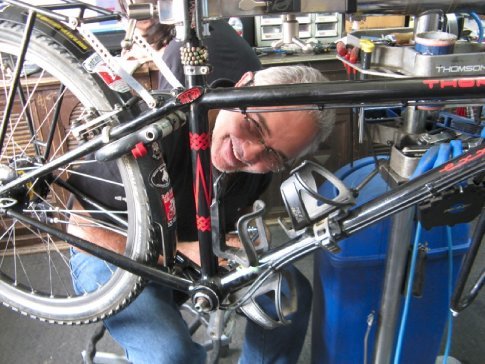
As we rolled back down the 20km hill we had climbed upon entering Manizales our bikes felt about as good as they had since we wheeled them out of the REI in Anchorage at the start of the trip.
In Manizales we also encountered Cristian, the ‘anti-biker’ also travelling by bike but heading north from Chile until here in Colombia - nicknamed the 'anti-biker' because he told Anna he refuses to stop to talk to other touring cyclists while he’s descending downhills, “i don’t want to know if other people are riding their bikes - i want to be the only one!” (sorry Cristian) but he actually turned out to be a super nice guy, hilariously funny and a good source of information for the journey south. Thanks Cristian! Here we are with Matt, another dutchie and Cristian out front of the Mountain House Hostel.
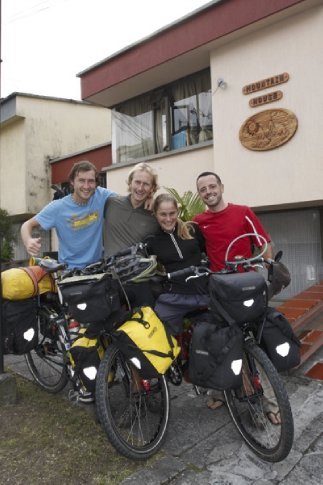
From Manizales we had hoped to reach Salento in one day, a small village in the mountains now on the backpacker trail due to it’s proximity to the ‘Valle de Cocora’, a spectacular valley in the foothills of the Los Nevados National Park where Wax Palms, (the national tree of Colombia) some up to 60m tall grow in surreal misty mountain scenery. After over 80 km, a large part of it climbing away from Pereira we came eye to eye with Salento, the only thing separating us was a 300 m or so deep canyon of 4km downhill, followed by 4km steep up. Exhausted, and in the fading afternoon light we made it into Salento.
In the first light of the following morning we took a loaded jeep (mostly other backpackers) deep up into the Valle de Cocora where the trails began. The lush green valley, dotted with granite boulders, dairy cows and a fast moving mountain river all overlooked by steep mountain peaks and blue skies would have been at home in the rocky mountains of the USA or the alps in Europe except for the tall wax palms that stood 50 to 60 tall standing guard over the hillsides, this is the Andes in Colombia. For the first time since the USA we were hiking through true mountain scenery. After leaving the green fields and wax palms in the sun, we entered the cloud forest, making several crossings over the river on log bridges to hidden mountain fincas with hummingbird gardens.

By then the clouds had moved in and we descended through a surreal scene of silhouetted wax palms back to an even more overloaded jeep to return to town.

Back in Salento we headed out with a small group to play a traditional Colombian bar sport, ‘Tejo’. Imagine a dusty bar, buzzing fluorescent lights, beer posters, and people playing a game kind of similar to ‘Bocce’ but with rules more akin to archery,a large clay square as the target some 15 metres away, then an ear shattering explosion of gunpowder, clay and smoke. This is ‘Tejo’! ‘Bang!’ as someone landed the lead weighted object on the centre ring of the clay, our ears were left ringing. The scoring was more about getting the weight onto the target, but the big score was the explosion of gunpowder. A fun way to spend an hour in a small Colombian town with some new friends, and some beers. This was followed up with a ‘bandeja’, (menu of the day) at ‘El Rincon de Lucy’, soup of platano and yuca, fried or grilled mountain trout, a banana, rice, lentils and a mango juice, all for a few dollars.
From Salento we took an adventurous dirt road to cross the same canyon from two days earlier and after a short sweaty climb (one where they use concrete strips for the road because otherwise it is too steep for cars too!) through the coffee plantations we enjoyed a long sustained downhill off the main highway in search of Pueblo Tapado, where we met up with Gonzalo, our warmshower’s host. He drove us out to his finca where we would stay for two nights under the roof of the old finca house with Fabio, the finca worker among platano trees and oranges. Gonzalo was also keen to show us around ‘una vuelta’ (a little round-trip) of the surrounding countryside in the ‘coffee axle’, so we took to the farm trails and dirt tracks on our touring bikes which ended up being an epic day ride of 85km running out of light as we returned into the city of Armenia.
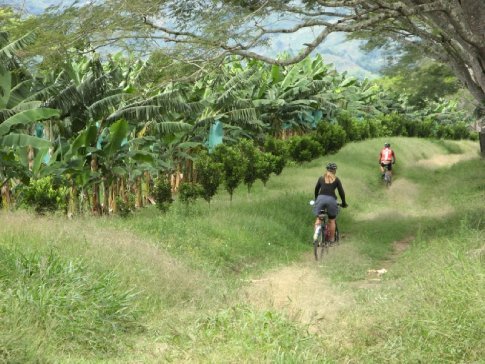
Thanks to Gonzalo for ‘una vuelta’ and sharing his knowledge on the region, on Colombia, on the changing climate and markets for agricultural products, for letting us stay on his finca and to Fabio for making us feel at home and for cooking us patacones (fried green platanos) over the fire our last night.
It was then back down to the heat of the Cauca river valley, long flat and straight stretches along the wide-shouldered but busy Panamericana to Cali, past vast crops of sugar cane, burning fields and sugar cane road-trains.
From Cali it was two days and some more climbing back up to Popayan the ‘Ciudad Blanca’, past villages full of mangos, the beat of african music singing from open houses, and black children dancing to the beat with their big white smiles. We couldn’t help but enjoy the music and the extremely cheap fresh mangos on the roadside.
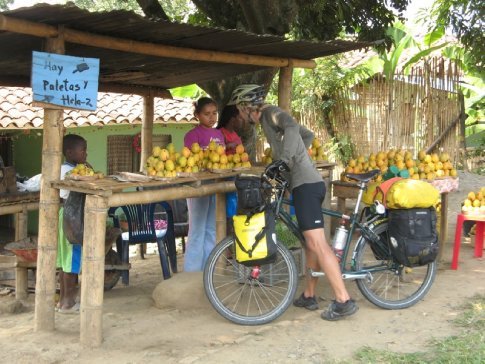
Popayan sits at 1700m with a mild climate and for over three hundred years was the original capital of southern Colombia, until Cali took over. As such it was a rich place where the owners of the sugar haciendas in the hot Cauca Valley, looking to escape the heat built mansions, schools, imposing churches and monasteries, all in chalk white facades with black window frames and colonial red-tiled rooves. The old town of Popayan was a delight to wander around with it’s cobble-stoned streets, fresh fruit vendors and colonial architecture and churches. Not to mention the Natural History Museum of Colombia with a fascinating if slightly morbid collection of stuffed birds, and animals of the region all enthusiastically painted.
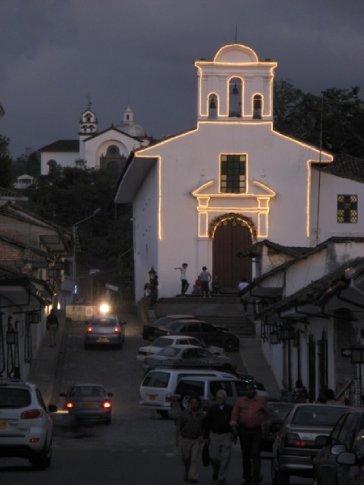
Iglesia La Ermita - the oldest church in Popayan

Popayan street art - highlighting the human rights of the indigenous people
From Popayan to San Agustin is 140 km but it was going to be a big climb up from 1700m to 3200m to cross the Cordillera Central on a rocky mountain road before descending back down to 1700m and San Agustin. Many cyclists choose not to ride this stretch of road and instead take a bus, notorious as a road in very poor condition, extremely remote with very few places to stay or get food and also once (and maybe still is) the territory of the FARC-EP (the Fuerzas Armadas Revolutionarias de Colombia - rebel group). With all these things in mind we headed off from Popayan, looking for some adventure, hoping to spend some time up in the Paramo (the high moor-like plains above 3000m in the Andes), and to get off the beaten track, away from the traffic of the Panamericana highway.
We broke the climb on the first day by stopping at the hot springs ‘Agua Hirvienda’ near Coconuco to soak our bones for the afternoon. The next day the paved road ended and the climbing began on loose rocky gravel roads. We climbed steeply through a lush green valley that the headwaters of the Cauca river have carved out, up to Paletara. After another roadside ‘bandeja’ with soup, mountain trout, rice, lentils and plantains we headed out onto the Paramo with the goal of reaching San Jose de Isnos for the day, still a mere 70 km away. The Paramo is a distinctive moor-like environment in the northern Andes, and the green, orange, red and brown hues of low alpine vegetation was reminiscent of the highlands of Tasmania with large daisy ‘frailejones’ standing like fields of sentinels in an otherwise barren landscape.

The dirt cobblestone road cut through the Paramo and headed towards a range of dark green ominous looking hills shrouded in a grey haze of cloud and rain.

We topped out at around 3200m in Volcan Purace National Park as the road became wetter we road past walls of impenetrable green cloud forest dodging puddles and potholes and being rewarded with an occasional glimpse of spectacular views of endless forest draped in clouds as far as the eye could see.
The problem was that the kilometres were not passing by too quickly. We continued to climb then dropped to a river, then climbed again. We had only come 20km since Paletara, it soon became clear we would not make it to Isnos the next town at this rate. Our thoughts then turned to a smaller town with ‘residencias’ (small family run hotels) at km 100, still 30km away or a restaurant where we could camp. A misty rain started and then the downhill really started. Guiding our loaded bikes around deep puddles, through rocky sections that would put some mountain bike trails to shame, our bikes were relatively flying along between 15 - 20 kph compared to the rest of the day.
We were passing through forest which is home to the spectacled bear (Oso andino) as well as the mountain tapir. So with some adrenalin rushing i half expected around every racing bend to see the elusive shape of a bear or a tapir shrinking into the green of the forest.
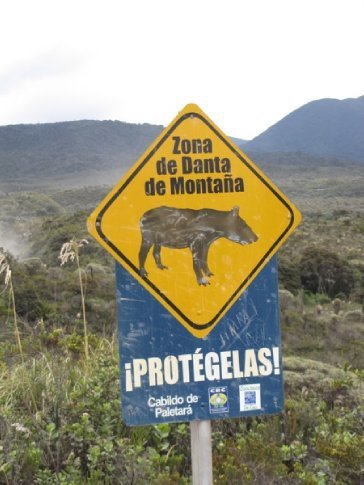
But alas, no bears, no tapirs, just the knowledge that they exist up here high in the Andean Paramo and cloud forest.
With the welcoming sight of a Parador (truck stop restaurant) at km 87, the first thing we had seen for over 40 km of remote forest riding, we asked if we could camp at the side of the restaurant. ‘Sure, not a problem’ the man told us. We set up camp alongside the restaurant next to a huge woodpile, the chicken yard (which always assures an early morning wake-up call) and a number of women toiling over large pots of boiling food. No sooner had Anna pulled the tent out of the bag, we were surrounded by six military personnel armed with semi-automatic weapons at their side, some only 18 years of age who curiously watched the crazy gringo couple on bikes set up their home. It turned out this Parador was also a military base and checkpoint, and we were not going to be alone here. We have never been observed setting up our tent under the watch of armed forces before, but they were just bored and curious as to why 1) you would want to ride your bike on a road like the one we just had? 2) why you would want to camp in the rain at a roadside restaurant?
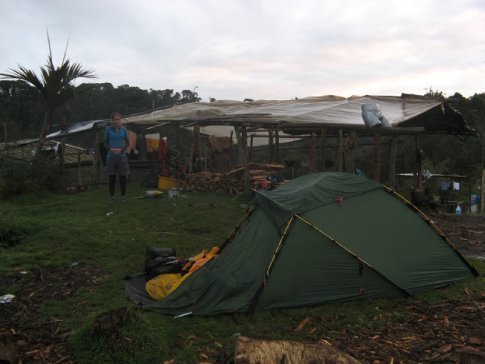
So we shared warm cups of coffee with these military boys, after an epic day on the road, checked out their weapons, answered their questions, tried to find out more of their lives, ate and then fell asleep under the shimmering Colombian stars, with the sound of bus engines idling by the ripe hour of 7:30pm.
The next day was mostly downhill to the heat of the Magdalena river valley, before a cruel, hot 5km climb up to the village of San Agustin and to the Casa de Ciclistas ‘Finca la Campesina’ with our hosts Igel, Paola, Rambo (the bike travelling rat terrier) and Costena (the gentle rottweiler).
San Agustin is the main archeological site in southern Colombia dating back 5000 years, with large stone statues carved from volcanic rock and depicting mythical creatures, humans and sacred animals scattered across the countryside along with many tombs, and carvings in river beds. The meaning of much of the archeological remains is open to interpretation as this civilisation had no written language and they had disappeared before the arrival of the Europeans, but it’s a nonetheless impressive feat of stone carving set in the rich and fertile hills of the Magdalena valley.
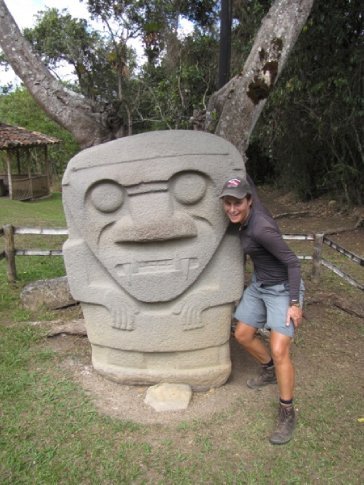

We also took to the saddle on horseback much to my intrepidation, but Anna’s excitement we rode rough dirt trails through the steep hills of the surrounding areas. This was no gentle excursion or introduction to horses for me, under the crack of the whip of our guide my horse took off into a gallop smashing it uphill, I just had to hold on. And like that, I learnt how to ride a horse complete with complimentary wounds on my bum.
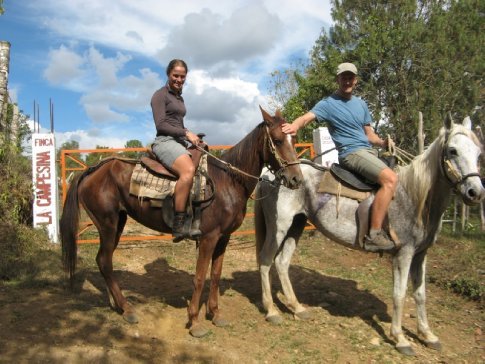
The Parque Archeologico and the surrounding countryside is the main attraction but for us it was also to visit the Casa de Ciclistas and institution of latin america where traveling cyclists are offered hospitality by other cyclists. In this place, Igel and Paola a german couple and bike touring family own a finca 1 kilometre from town where they have camping areas, kitchen and bathroom for travelling bikers.
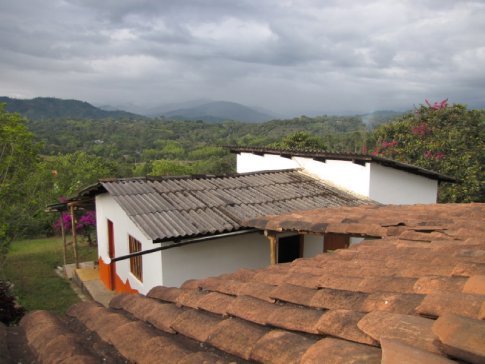
We have spent the past 5 days here on the finca celebrating Christmas with Igel and Paola at the Casa de Ciclista, cooking wood oven pizzas, eating good food, hanging out with the dogs, sharing stories of the road and doing very little. Although Anna is rediscovering her artistic side painting hummingbirds and hedgehogs in the new casita, while I learnt that digging out clay soil and building a footpath in my attempt to do some real work with my ‘soft’ cyclist’s hands will result in blisters!
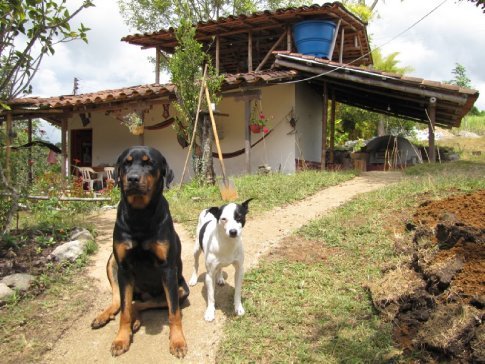
Costena y Rambo at the Casa de Ciclistas

Muchas gracias a Igel, Paola, Rambo, Costena y Teo for our relaxing time on the finca.
The next leg of our journey is a dirt mountain road between Mocoa back up into the Andes to Pasto and then into Ecuador.
Hasta la proxima vez
Ali and Anna